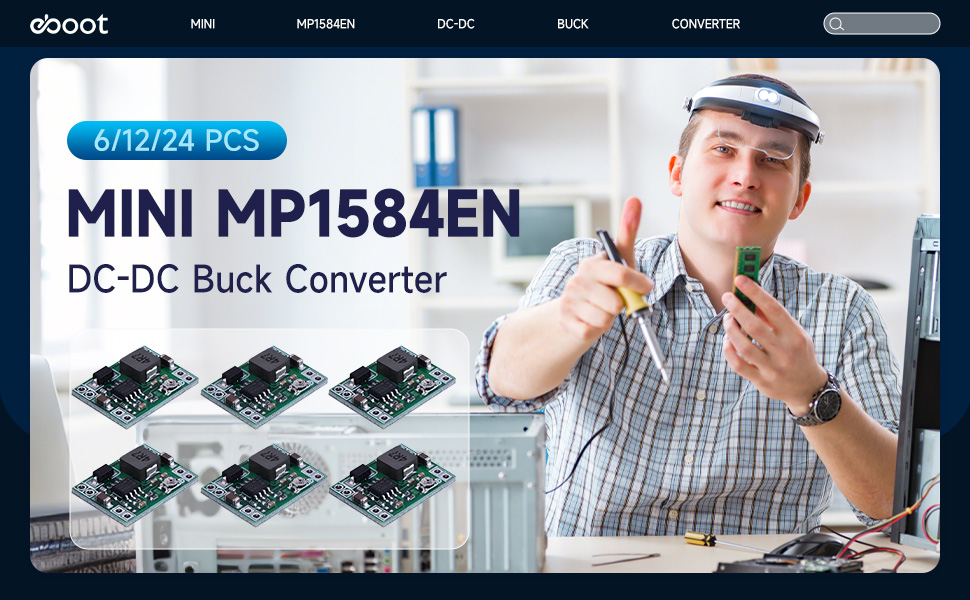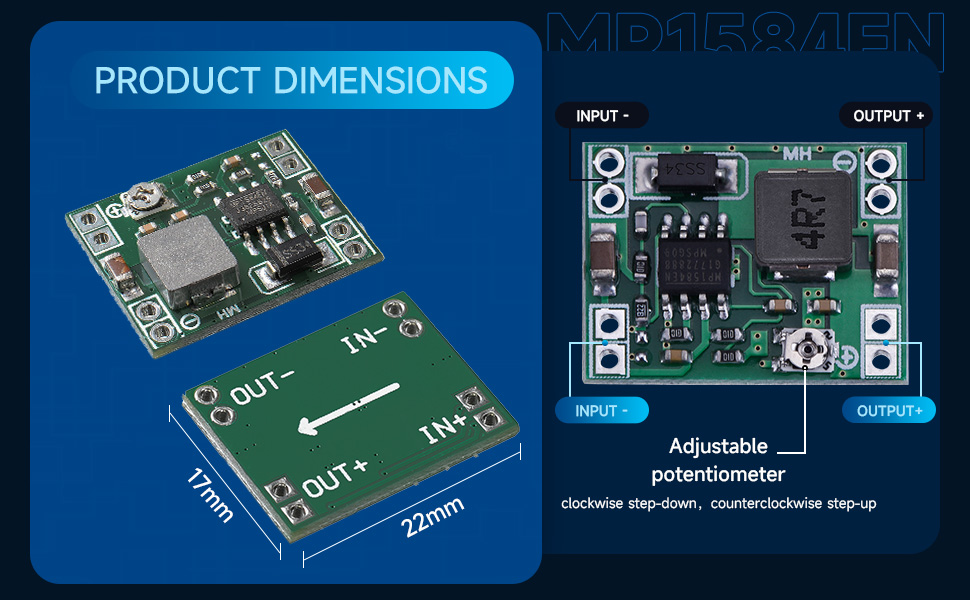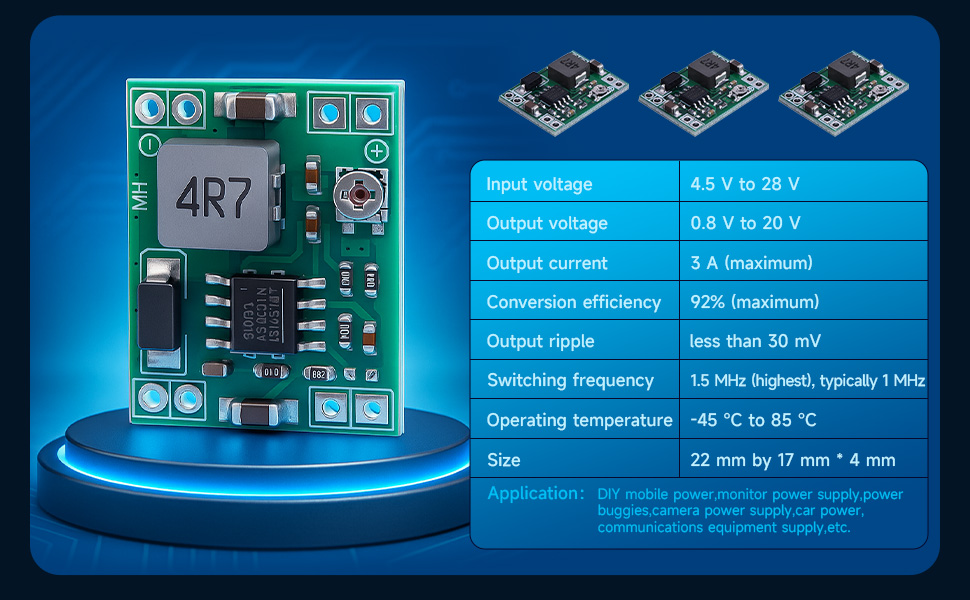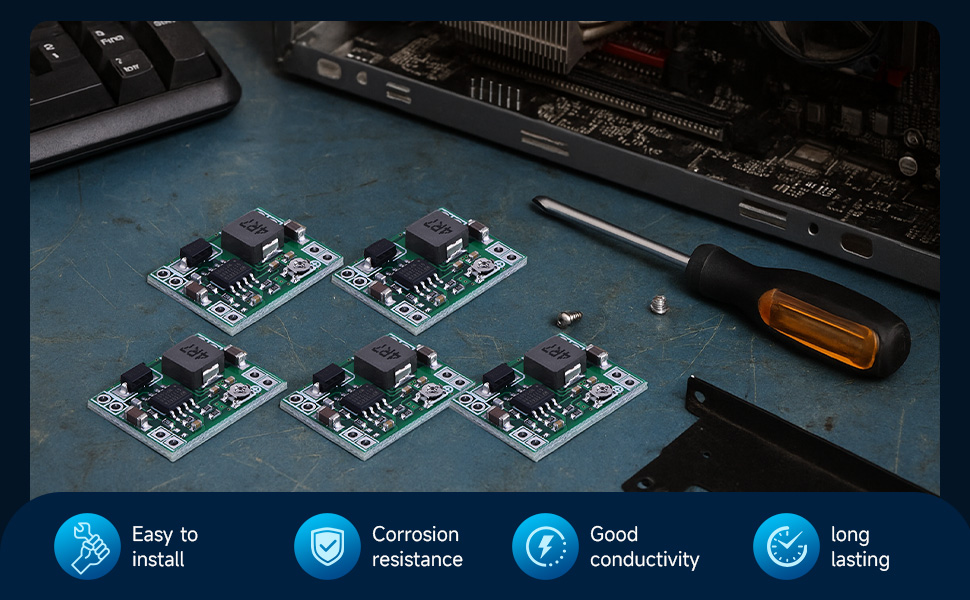







🔧 Power your creativity with precision!
The eBoot 6 Pack Mini MP1584EN DC-DC Buck Converter is a compact and efficient power supply module designed for versatile applications. With an input voltage range of 4.5V to 28V and adjustable output from 0.8V to 20V, it delivers a maximum output current of 3A with an impressive conversion efficiency of up to 92%. Its robust design operates effectively in extreme temperatures, making it an essential tool for any DIY enthusiast or professional engineer.





| Current Rating | 3 Amps |
| Minimum Frequency | 50 Hz |
K**.
Great product
Great product, work as described.
T**T
Dont even skimp on voltage regulators or you will pay for it.. these are great!!!
Excellent adjustable buck style voltage regulators.. don't get hot, provide a soild voltage feed with raises and falls that stay within 1 to 2 hundredths a volt.. give a fairly clean output voltage (still need a LC filter if you want very clean wave forms) provides 0.6 to 23 volts from my testing.. able to pull a constant 3.5 amps off it at 16.8v without it getting hot 2.5amps at 20volts gets warm but ok... 3amps at 20v will cook the coil in about 20 minutes.. at 12v I was able to pull a solid 4.2a off it for 2 hours and the temp never got above 97F, 4.5a at 12v smoked it in 7 minutes...If you cook the coil on it it does NOT allow full voltage to pass through (I have had some buck regs fail and allow full voltage to pass through for a few seconds.. I killed two of these intentionally to make sure that when it failed no voltage pass through and on neither one did that happen and that makes me VERY HAPPY. A failure acts like a breaker, it fails it fails and circuit is instantly broken.. I tested this with a O-scope and it had 0ms of full voltage seep when it failed..) These are incredibly cheap and excellent quality.. over preform and stay dang steady.. These are without a doubt the best cost to preformance ratio bucks you can buy...Bucks are not a place to skimp and buy as cheap as possible BECAUSE a failure on a buck that is supplying constant regulated voltage to high dollar electronics and fail and allow unregulated voltage to seep by for even a 1ms can damage sensitive to voltage electronics and ruin your day and make you wish you wouldn't have saved that 30 cents per piece.
D**G
Great function, puzzling form factor
The actual functionality of the product is really good. This is a high efficiency buck converter, good for actually pretty decent loads, and you get 6 of them. They're extremely easy to use and the build quality is good too, aside from the functional but impossibly cheap set screw.The only bad thing is there are no mounting holes, no great way to secure this in any project you might be working on, and the through holes for in and out are irregularly spaced so it can't be used on a breadboard or a wire wrap board! Each pair of in/out pins have 0.1" standard spacing but their distance from one another is not on that grid so you'll never seat this board on to anything but a custom PCB! Baffling. Even worse because there are no other mount points.
N**U
Worked great in the beginning
It worked great when I tested one of them. So I permanently glued it to my setup. And now the potentiometer is not changing the voltage on 3 of them. I am pretty sure I didn’t turn it too far but who knows maybe I applied too much force. So just be gentle I guess. Giving it 1 star because the product was great when it worked. But didn’t even last a few seconds of adjustments.EDIT: I changed my mind. They are working really good now. Yeah the potentiometer can be finicky but it works. By trial and error you can get the right voltage. Just be careful to go really slow and gentle while changing voltage. Don’t push down too hard and turn slowly.
J**.
Adjustable voltage
I’m an Escape Room owner and have used these many times to reduce 12vdc voltage to 9v, 6v, 4.5v to power different escape room technical props/puzzles. I’ve also used to replace battery operated Halloween props like blow mold pumpkins using a 12v power supply and knocking down the voltage to replace the need for batteries. Cat5 wire or speaker wire works well, in a pinch, to accomplish this.As others have mentioned, adjusting voltage is a bit tedious and requires a small (tiny) screwdriver and it is somewhat hard to dial in, but it works with a little patience. Make sure your input power and polarity is correct or you will fire the circuit board. I tend to use a large heat shrink tube to enclose/protect the circuit board after hooking things up.
P**N
Way too hot with 1.9 amp load in less than a minute. Returning them
These are supposed to be good up to 3 amps. With 12v in and 3.75v out into a 2 ohm resistor, (meaning less than a 2 amp draw), in less than a minute it became "dangerously hot". To me that means when I touched it, I burned my finger slightly. That means it is too hot to use in a normal application. The voltage output was stable for the short time I was able to test it, but with that much heat, I had to quickly disconnect it so I have no long term data.I got the 12 pack and only opened the one I tested. They are all going back because I don't want to risk it. I was disappointed.
A**
Excellent adjustable voltage
Works awesome!! Best I've ever used!! Great price!!
Trustpilot
1 month ago
4 days ago
2 months ago
2 months ago